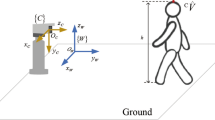Abstract
The purpose of this study was to extract the three-dimensional (3D) vector of the baseline drift baseline drift vector (BDV) of the specific points on the body surface and to demonstrate the importance of the 3D tracking of the body surface. Our system consisted of a near-infrared camera (NIC: Kinect V2) and software that recognized and tracked blue stickers as markers. We acquired 3D coordinates of 30 markers stuck on the body surface for 30 min for eight healthy volunteers and developed a simple technique to extract the BDV. The BDV on the sternum, rib, and abdomen was extracted from the measured data. BDV per min. was analyzed to estimate the frequency to exceed a given tolerance. Also, the correlation among BDVs for multiple body sites was analyzed. The longitudinal baseline drift was observed in the BDV of healthy volunteers. Among the eight volunteers, the maximum probability that the BDV per min. exceeded the tolerance of 1 mm and 2 mm was 30% and 15%, respectively. The correlation among BDVs of multiple body sites suggested a potential feasibility to distinguish the translational movement of the whole area and the respiratory movement. In conclusion, we constructed the 3D tracking system of multiple points on the body surface using a noninvasive NIC at a low cost and established the method to extract the BDV. The existence of the longitudinal baseline drift showed the importance of the 3D tracking in the body surface.










Similar content being viewed by others
Data availability
Not applicable.
Code availability
Not applicable.
References
Videtic GM, Stephans K, Reddy C et al (2010) Intensity-modulated radiotherapy-based stereotactic body radiotherapy for medically inoperable early-stage lung cancer: excellent local control. Int J Radiat Oncol Biol Phys 77(2):344–349
Yamashita H, Haga A, Takahashi W et al (2014) Volumetric modulated arc therapy for lung stereotactic radiation therapy can archive high local control rates. Radiat Oncol 9:243
Giraud P, Yorke E, Jiang S, Simon L, Rosenzweig K, Mageras G (2006) Reduction of organ motion effects in IMRT and conformal 3D radiation delivery by using gating and tracking techniques. Cancer Radiother 10(5):269–282
Worm ES, Hoyer M, Fledelius W, Hansen AT, Poulsen PR (2013) Variations in magnitude and directionality of respiratory target motion throughout full treatment course of stereotactic body radiotherapy for tumor in the liver. Acta Oncol 52(7):1437–1444
Takao S, Miyamoto N, Matsuura T et al (2016) Intrafractional baseline shift or drift of lung tumor motion during gated radiation therapy with a real-time tumor-tracking system. Int J Radiat Oncol Biol Phys 94(1):172–180
Seppenwoolde Y, Shirato H, Kitamura K et al (2002) Precise and real-time measurement of 3D tumor motion in lung due to breathing and heartbeat, measured during radiotherapy. Int J Radiat Oncol Biol Phys 53(4):822–834
Zhao B, Yang Y, Li T, Li X, Heron DE, Huq MS (2012) Dosimetric effect of intrafraction tumor motion in phase gated lung stereotactic body radiotherapy. Med Phys 39(11):6629–6637
Peulen H, Belderbos J, Rossi M, Sonke JJ (2014) Mid-ventilation based PTV margin is stereotactic body radiotherapy (SBRT): a clinical evaluation. Radiother Oncol 110(3):511–516
Tarohda TI, Ishiguro M, Hasegawa K et al (2011) The management of tumor motions in the stereotactic irradiation to lung cancer under the use of Abches to control active breathing. Med Phys 38(7):4141–4146
Thiyagarajan R, Shinha SN, Ravichandran R et al (2016) Respiratory gated radiotherapy-pretreatment patient specific quality assurance. J Med Phys 41(1):65–70
Cheung Y, Sawant A (2015) An externally and internally deformable, programmable lung motion phantom. Med Phys 42(5):2585–2593
Freislederer P, Reiner M, Hoischen W et al (2015) Characteristics of gated treatment using an optical surface imaging and gating system on an Elekta linac. Radiat Oncol 10:68
Willoughby T, Kupelian P, Pouliot J et al (2006) Target localization and real-time tracking using the calypso 4D localization system in patients with localized prostate cancer. Int J Radiat Oncol Biol Phys 65(2):528–534
Onishi H, Kawakami H, Marino K et al (2005) A newly developed simple and accurate respiratory indicator relative to measurement of 2-point levels of abdominal and chest walls: for assurance of patient self-judged breath holding techniques for irradiation of lung cancer with small internal margin. Int J Radiat Oncol Biol Phys 63:S534
Fayad H, Pan T, Pradier O, Visvikis D (2012) Patient specific respiratory motion modeling using a 3D patient’s external surface. Med Phys 39(6):3386–3395
Lachat E, Macher H, Landes T, Grussenmeyer P (2015) Assessment and calibration of a RGB-D camera (Kinect v2 sensor) towards a potential use for close-range 3D modeling. Remote Sens 7(10):13070–13097
Saito A, Ohashi A, Nishio T et al (2019) Automatic calibration of an arbitrarily-set near-infrared camera for patient surface respiratory monitoring. Med Phys 46(3):1163–1174
Acknowledgements
This research was supported by AMED under Grant Number 16he1002008h0002. We would like to thank Editage (www.editage.jp) for English language editing.
Funding
This research was supported by AMED under Grant Number 16he1002008h0002.
Author information
Authors and Affiliations
Contributions
AO: Writing—Original draft, Software, Investigation, Methodology. TN: Project administration, Funding acquisition, Conceptualization, Writing—Review and editing. AS: Writing—Review and editing, Software, Methodology, Validation. DH: Software. HM: Software. YM: Methodology, Validation. SO: Investigation. MS: Software. MT: Software. HW: Investigation. KI: Supervision. YN: Supervision.
Corresponding author
Ethics declarations
Conflict of interest
The authors have no conflicts of interest to declare that are relevant to the content of this article.
Ethical approval
This study was approved by Institutional Review Board of Hiroshima University (E-542).
Consent to participate
Informed consent was obtained from all individual participants included in the study.
Consent for publication
The participant has consented to the submission of the scientific article to the journal.
Additional information
Publisher's Note
Springer Nature remains neutral with regard to jurisdictional claims in published maps and institutional affiliations.
Rights and permissions
About this article
Cite this article
Ohashi, A., Nishio, T., Saito, A. et al. Baseline drift vector of multiple points on body surface using a near-infrared camera. Phys Eng Sci Med 45, 143–155 (2022). https://doi.org/10.1007/s13246-021-01097-w
Received:
Accepted:
Published:
Issue Date:
DOI: https://doi.org/10.1007/s13246-021-01097-w




